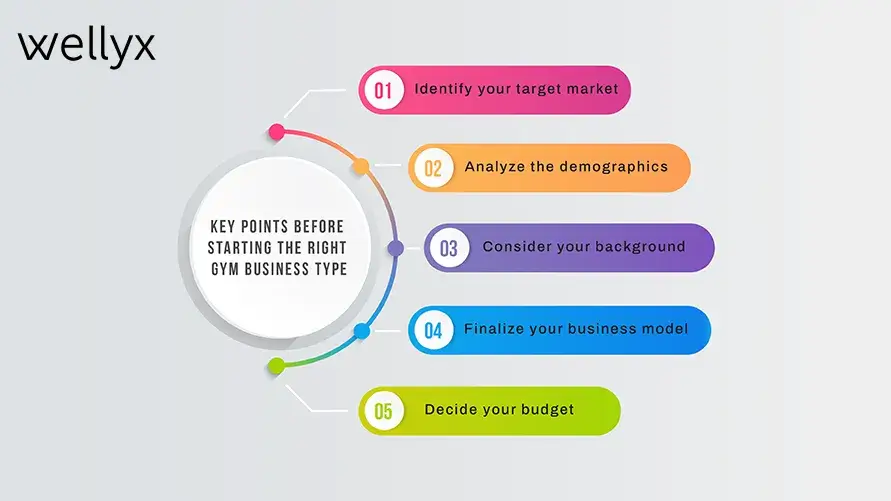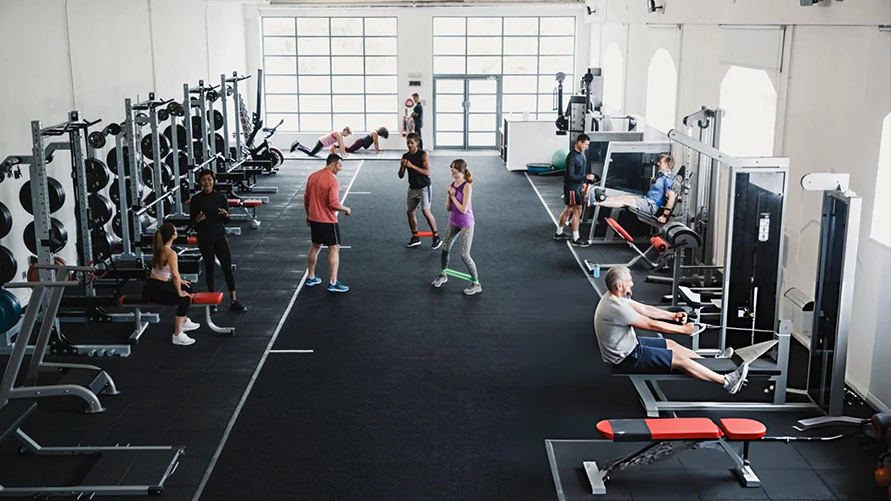The fitness industry is currently experiencing an extraordinary boom, with more people committing to healthier lifestyles. But in this expansive and competitive market, there is no one-size-fits-all approach. Different types of gyms have evolved to meet the diverse needs of modern fitness enthusiasts. From traditional gyms and boutique studios to luxury fitness centers and CrossFit boxes, the options are abundant.If you’re thinking about launching your own fitness business, it’s essential to understand the various types of gym models to make a smart and strategic decision. Let’s dive into the different gym types that can shape your entrepreneurial journey.
Must-know types of gyms for gym owners
Before you start your gym business, knowing what type of gym fits your mission, vision, and target audience is crucial. Research about your chosen type, the market size, potential for growth, and target audience before diving in. So, to choose the right type of gym model, let’s explore the most popular and profitable gym types to consider:
1. Traditional gyms
Traditional gyms are the most common types of gymnasium. These gyms are more like an umbrella term for all the individual fitness categories. They offer a wide variety of workout equipment, including free weights, treadmills, ellipticals, rowing machines, stationary bikes, squat racks, and cable machines. Basically, these gyms cater to people who want diverse equipment options and are not looking for specialized classes.
These gyms are usually busy because of their all-rounded approach. So, if you are looking to start a traditional gym business, it is important you are prepared. You must offer a large range of equipment and should have ample space.
When it comes to the environment of traditional gyms, they provide a functional and friendly atmosphere. Traditional gyms are not required to be luxurious but roomy, clean, and well-kept.
Estimated costs
Before expecting revenue generation, you must put in an initial investment and also consider monthly expenses that can vary by size and location. For these type of gyms, the initial investment is roughly between $50,000 to $100,000.
2. CrossFit gyms
In recent years, CrossFit has gained immense popularity in the fitness industry. So, it is only natural that we see a lot more Crossfit gym types around us. These gyms are for the fitness enthusiasts who enjoy challenging and high-intensity workouts. The workouts involving strength, cardio, and mobility training are the top-sellers.
Since CrossFit gyms attract people who love to push their limits, they focus on combined and functional movements, such as squatting, lifting, and pulling at a high intensity. When it comes to equipment, these gyms include barbells, kettlebells, pull-up bars, and medicine balls.
These types of gym facilities are all about performance, motivation, and community-building. More often than not, these gyms are light on pocket and don’t require expensive decor or extensive equipment, making them more affordable for people looking to start a fitness business.
Estimated costs
The initial capital required for opening a CrossFit gym ranges from $20,000 to $50,000. And for the monthly expenses, CrossFit gym can cost you around $10,000 to $20,000 for all expenditures.
3. Family gyms
Different gyms cater to a particular audience, and as per their name, family gyms are suitable for teenagers, adults, and older people, respectively. For each age group, there are different types of fitness workouts and equipment. According to their goal, people can choose their workouts and even instructors and trainers to get the ball rolling.
Family gyms create a sense of responsibility among people and help them work on their physical as well as mental health. These types of fitness centers often include play areas, pools, group classes, and senior wellness programs. They’re a one-stop shop for multigenerational fitness and social engagement.
Their design is warm, welcoming, and suitable for all age groups. Family gyms cater to the preferences of different age groups and include workouts like strength, flexibility, endurance, and balance.
Estimated costs
If we talk cost-wise, family gyms can burn a hole in your pocket. It is because you will have to consider every age group and design your facility accordingly. So, it can cost you from $100,000 to $200,000 as an initial investment with a monthly expense of around $20,000 to $40,000.
4. Boutique gyms
Among different types of gym facilities, boutique gyms are another common type. These gyms are specialized fitness centers that are typically smaller and more focused than traditional gyms. They often feature modern amenities and trendy designs to offer a more luxurious and personalized experience to their member base.
Boutique gyms typically concentrate on a particular fitness area, such as cycling, HIIT, yoga, or personal training. In addition to that, members get better attention during their classes due to fewer members. So, it helps provide a more individualized experience while creating a sense of community and belongingness among members.
Members are drawn to boutique gyms for their exclusivity, premium experience, and the chance to be part of a fitness community with an upscale atmosphere. These gyms reflect a lifestyle, not just a workout.
Estimated costs
Boutique gyms, being a trademark of luxury, require a hefty initial capital. Opening a boutique gym may cost you around $100,000 to $300,000. Regarding the monthly expenditures, running a boutique gym may cost you from $20,000 to $50,000.
5. Pilates studios
Pilates is another form of fitness workout that is low-intensity and strengthens the core muscles while improving flexibility and mobility. And it is among the hot trends in the fitness community. The workouts can vary from beginner level to a more advanced level, and the equipment includes reformers that use springs for resistance and support to enhance the workouts.
Pilates studios can be lucrative if you are looking to start a Pilates facility. The customer base is normally people looking to develop a better mind-body connection. These workouts help them understand their bodies and encourage focus.
To provide a decent experience to your members, you can offer a variety of services according to your budget. Typically, your audience expects core Pilates classes, specialized Pilates classes (prenatal/postnatal, athletic, and for seniors), and additional classes, such as yoga and barre.
When it comes to the design and ambiance, the primary purpose of Pilates studios is to offer a calm and modern atmosphere.
Estimated costs
Opening a Pilates studio requires an initial investment of around $50,000 to $100,000. However, the amount depends upon the size, location, and amenities of your studio. Regarding the monthly expense, it can cost you from $2,000 to $5,000.
6. Athletic gyms
Athletic gyms are perfect for fitness enthusiasts and athletes looking to improve their sports performance. They offer a wider range of activities and amenities beyond traditional gyms. So, what makes them different from crossFit gyms, you’d ask? Well, these gyms are not entirely about the workouts but rather offer sports activities.
Spaces for sports like basketball, tennis, swimming etc., alongside weight training and cardio areas are elements that make them different from other gym types. These are a whole package and may offer personal training and other wellness services like steam rooms and saunas.
Many athletic clubs operate on a membership base plan, offering access to all facilities and activities for a monthly or annual fee. To keep athletes motivated, these gyms offer an energetic and motivating environment and focus on facilitating their memberbase with cafes and childcare services as well.
Estimated costs
To start an athletic gym, you must have a budget of around $200,000 to $500,000. In addition, your monthly expenses may cost around $30,000 to $60,000 to keep up with your gym’s requirements.
7. 24-hour accessible gyms
People with difficult work routines prefer flexibility when it comes to joining a gym. For such fitness fanatics who look for ultimate convenience, a 24-hour accessible gym is the best option. These gyms are more like traditional gyms, but there is no restriction on hours. So, these gyms are the places where working out and sweating never stop.
24-hour accessible gyms offer a wide range of gym equipment. These may include treadmills, rowing machines, free weights, ellipticals, and more. So, you can offer cardio training, high-intensity workout, and strength training. Flexible gyms have a larger member base due to their convenience and easier accessibility.
In addition to that, these gyms have a simple yet functional ambiance. To put it simply, 24-hour accessible gyms are well-maintained, clean, and safe. So, such gyms help you cater to your members without any hassle.
When it comes to initial capital for starting a 24-hour accessible gym, keep in mind that it will cost you around 50,000 to 100,000 USD. For monthly expenses, your budget must range from 15,000 to 30,000 USD.
8. Luxury gyms
People who seek luxurious and elite gym experiences prefer joining a luxury gym. A luxury gym is not an ordinary gym, but it offers exclusive services to boost members’ experiences. It may include futuristic pieces of equipment, a salon and spa, and other amenities. Basically, it gives you the vibe of a well-established club, providing a luxurious lifestyle to your members.
When it comes to the services of luxury gyms, they include personal training, personal care, massage therapists, and nutritionists. In luxury gyms, the facility must have steam rooms, fitness apparel boutiques, spa spaces, saunas, and more. Since elite members join luxury gyms, they pay well for the premium services.
In addition, the ambiance of luxury gyms is ultramodern and highly developed. Such gyms provide a sense of exclusivity and extravagance. So, luxury gyms come with large lounge spaces with aesthetic but comfortable seating, ambient lighting to pump up the mood, and more.
Since luxury gyms demand state-of-the-art equipment and every other thing, they require a hefty initial capital. To open a luxury gym, the budget ranges from 200,000 to 500,000 USD. in addition, you must have a higher monthly budget of around 30,000 to 50,000 USD.
How to choose the right gym type before starting a business?
Starting your own gym business is a big step, right? This is not something that you plan and execute overnight. It is a major investment of time, energy, and money, of course. To start your gym, it is vital to consider your goals, interests, market trends, and more. But, the most significant factor to consider is the type of gym.

So, if you are unsure what gym type would be best for you, we have got you. Take a look at the following factors to figure out the right gym type for you:
So, if you are unsure what gym type would be best for you, here are the key factors to consider when selecting your gym model:
Identify your target audience
First step here is to know who you are to serve, i.e., your target audience. The type of gym you choose will determine your customer base.Fitness fanatics, casual gym-goers, families, or seniors, each of these groups has specific needs. If you don’t offer services that cater to your target audience, then your gym cannot be successful.
But if you are looking to establish a successful gym and want to generate revenue and grow steadily, you need to pay utmost attention to this aspect of business planning.
Analyze the demographics
Second important element in business planning is knowing demographics and choosing your location that helps you practically implement your plan. Some important factors to consider when choosing your location include, population density, income levels, and competitor presence.
These details and insights will help you choose the most appropriate type of gym for your market.
Consider your expertise
If you’re a certified trainer or wellness coach, you must leverage your specialty. For example, Pilates instructors might prefer opening a boutique or Pilates studio. Similarly, a high-intensity trainer may be better off with a CrossFit studio.
Define your business model
Whether your revenue will come from memberships, personal training, group classes, or hybrid models is something you need to decide before diving in. And once you establish your business, if there is room for addition in your services, you can gradually add them. Start smart and steady, don’t rush in, and stick to one pace. In the longer run, this is the recipe for a successful gym.
Determine your budget
The most important factor to consider is your budget. Your available capital will help you launch the type of gym you end up choosing.
Choosing the right gym management software
Even before you have launched your gym, you must be mindful of everyday management. For new gym owners, it can be quite intimidating to manage their gym along with focusing on expansion, right? That’s where Wellyx gym management software comes in. It helps automate your daily workflows so you can focus on growth. It comes with a wide range of features, including:
- Automated scheduling
- Online payment
- Access control
- Lead generation
- Automated marketing
- Customized branding, etc.
Final thoughts
Launching your own gym starts with choosing the right gym type. By understanding the different types of gym models, evaluating your goals, and analyzing the market, you can make an informed decision that sets your business up for long-term success. Whether you go for a traditional setup or explore different gym types that cater to specific communities, the right start makes all the difference.





